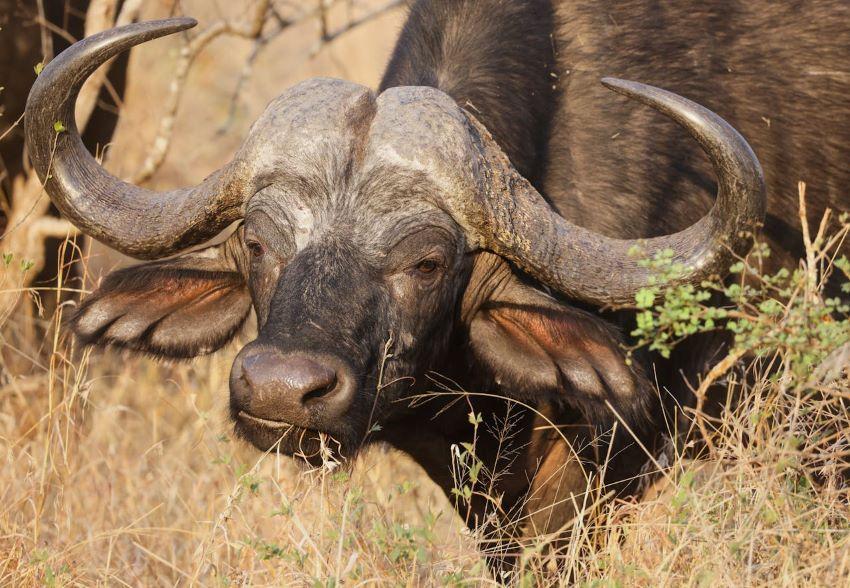This is the first segment of a two-part blog relating to Cape African Buffalo Hunts.
If you are looking to hunt an iconic and challenging dangerous game hunting species, look no further than the African Cape buffalo. Aggressive, unpredictable, dangerous, and cunning, this member of the Big 5 and Dangerous 7 is a worthy adversary for a big game hunting safari!
[DYNAMIC-BLOGTABLEOFCONTENT]
Introduction
- Africa’s buffalo species are as diverse as they are impressive, with four distinct subspecies that include the robust forest buffalo, the West African savanna buffalo, the Central African buffalo, and the iconic southern savanna buffalo, known as the Cape buffalo.
- Savanna buffaloes are often likened to large, cow-like animals, distinguished not only by their size but also by the unique shapes of their horns and their striking range of colors. Typically, these majestic creatures are dark grey or black, though their appearance can vary dramatically—sometimes appearing reddish or even white after indulging in mud baths of those colors.
- The younger buffaloes often sport a reddish-brown coat, adding to their intriguing color palette. On the other hand, the smaller forest buffalo retains its reddish hue throughout its life, a feature particularly notable in certain regions, like western Uganda.
- Both male and female buffaloes possess formidable, ridged horns that either project straight out from their heads or curve downward before sweeping upward. These horns serve a dual purpose as potent weapons against predators and tools for asserting dominance within the herd. Males, especially, engage in intense clashes to establish hierarchy and secure access to vital resources.
- With their diverse colorations and impressive horns, African buffaloes symbolize resilience and adaptability in their natural environment. They are a fascinating subject of study and admiration, embodying the spirit of Africa’s untamed wilderness.
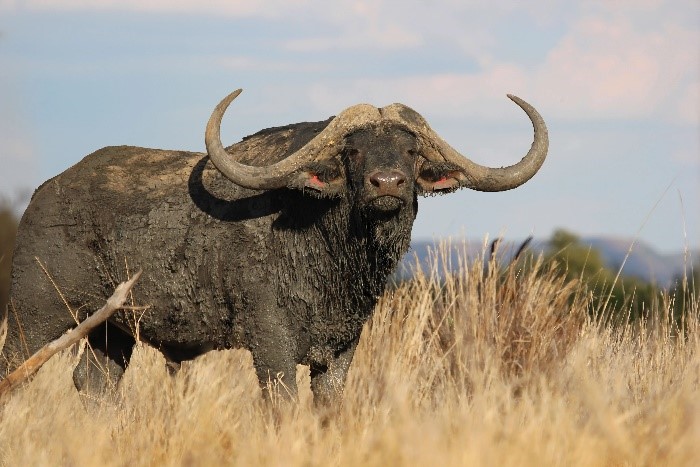
An Overview of Dangerous Game Hunting
Hunting in Africa spans millennia and has evolved alongside cultural shifts, technological advances, and environmental changes. It has deep roots in human history, initially serving as a means of sustenance where early humans crafted tools and utilized fire to aid their pursuits.
Archaeological evidence, such as that found at South Africa’s Pinnacle Point Caves, illustrates a diverse diet that included animals like dassie, Cape fur seal, wildebeest, and buffalo.
Beyond practicality, hunting held ritual and artistic significance, as depicted in ancient rock art that portrays hunting scenes and ceremonial practices. Indigenous tribes across Africa developed specialized hunting techniques, such as the Bushmen’s endurance-based persistence hunts and the strategic use of spears and clubs by groups such as the Zulu and Maasai.
With the arrival of European settlers, hunting dynamics shifted dramatically with the introduction of firearms. This era marked the beginning of large-scale game hunting for trade and sport, popularizing the image of the “Great White Hunter” and leading to the exploitation of Africa’s wildlife for trophies, ivory, and skins
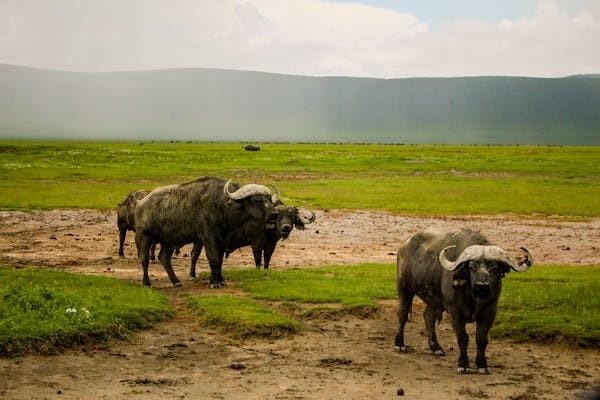
Summarised Key Factors that emerged during the era of the “Great White Hunter”
1. Explorers and Personalities
-
- Famous figures like Theodore Roosevelt, Frederick Selous, and Robert Baden-Powell embodied the Great White Hunter image.
- Their expeditions and writings, filled with big game hunting adventures, were widely publicized and admired.
2. Commercial Interests
-
- The safari industry capitalized on this image, offering organized hunts to wealthy Europeans and Americans.
- Safari companies marketed these trips as prestigious and adventurous, attracting affluent clients eager for the thrill of big game hunting.
Leading to Exploitation
1. Demand for Trophies
-
- People wanted exotic trophies like lion skins, elephant tusks, and rhinoceroses’ horns, fuelling extensive hunting.
- Trophy rooms and museums across Europe and America showcased these prizes as symbols of status and adventure.
2. Ivory Trade
-
- The high demand for ivory in Europe and America led to the mass killing of elephants.
- This trade was highly profitable and significantly reduced elephant populations.
3. Skins and Pelts
-
- Skins of African animals like leopards and zebras were sought after for fashion and decor.
- Commercial hunting for these valuable skins led to severe population declines.
4. Unregulated Hunting
-
- During the colonial era, hunting regulations were either non-existent or poorly enforced.
- Hunters could exploit wildlife populations without any restraint.
Consequences
1. Decline in Wildlife Populations
-
- Overhunting drastically reduced populations of many iconic African species.
- Some species faced near extinction due to excessive trophy hunting and poaching.
2. Ecological Impact
-
- Removing key species disrupted ecosystems and altered the balance of the natural environment.
- Losing large predators and herbivores had cascading effects on other wildlife and habitats.
3. Cultural and Social Effects
-
- The Great White Hunter image overshadowed the rich hunting traditions of Indigenous African peoples.
- Local communities often suffered from wildlife depletion, losing vital resources and cultural heritage.
Modern Reassessment
Today, there’s growing awareness and criticism of the Great White Hunter legacy. Conservation efforts and sustainable game hunting practices are now emphasized to protect Africa’s wildlife for future generations. The focus has shifted from exploitation to conservation, recognizing the importance of maintaining biodiversity and respecting Africa’s natural and cultural heritage.
Interesting Facts to Consider Prior to your African Cape Buffalo Hunt
Venturing into dangerous game hunting, especially an African Cape buffalo hunt, requires critical information and understanding of the unique and intriguing facts about these formidable animals.
General Cape Buffalo Facts
- Cape buffalos are members of the Bovidae family.
- Male Cape buffalos are called bulls, and females are referred to as cows.
- Their diet consists almost entirely of grass, making them herbivores.
- Cape buffalos are known for their unpredictable and aggressive nature.
- They are often nicknamed “Black Death” or “Widowmakers.”
Cape Buffalo Physical Characteristics
- Male Cape buffalos typically weigh between 1,100 to 2,000 pounds (500 to 900 kg), while females weigh around 770 to 1,365 pounds (350 to 620 kg).
- They can stand up to 5.7 feet tall (175 cm).
- Cape buffalos are capable of running at speeds of up to 35 mph (57 kph).
- Males generally exhibit darker coloration compared to females, often indicating dominance.
- Male Cape buffaloes often roll in mud, a behaviour that darkens their skin.
- They have thicker necks and shoulders than females.
- Male Cape buffalos possess thicker horns, whereas females typically have longer ones.
- The largest recorded horn from a Cape buffalo measured 64 inches (163 cm) in length and belonged to a female.
- Male Cape buffalos have horns that meet in the middle, forming a tough, solid area known as a boss, which is capable of stopping bullets.
Cape Buffalo Habitat
- Cape buffaloes roam across a wide range of habitats throughout sub-Saharan Africa, including savannas, wetlands, shrublands, grasslands, forests, and even deserts.
Conservation Status of Cape Buffaloes
- Currently, Cape buffaloes are classified as Near Threatened. According to the IUCN, there are approximately 398,000 to 401,000 Cape buffalos remaining in their natural habitats in the wild.
Cape Buffalo Life Cycle
- In the wild, Cape buffaloes can live up to 22 years, but their average life expectancy is around 11 years. In captivity, they can live up to 29 years.
- Cape buffaloes reach sexual maturity between 3 to 5 years of age.
- The gestation period for a female Cape buffalo is between 11 and 11.5 months.
- Female Cape buffaloes usually give birth to one calf at a time, with newborn calves weighing between 66 and 132 pounds (30 to 60 kg).
- Females are responsible for raising the calves, and sometimes adopt orphaned calves.
Cape Buffalo Social Structure
- Cape buffalos are very social and typically form groups of 15-20 individuals called herds.
- Herds consist of related females, their calves, and a smaller number of males.
- Female buffaloes decide the direction in which the herd moves.
- Males often fight each other to establish dominance within the herd.
- During mating season and long migrations, herds can swell to as many as 3,000 members.
- Older males that are no longer reproductive often leave their herd and either live alone or form small groups with other older males.
Cape Buffalo and Natural Enemies
- Lions are the most common predators of Cape buffaloes.
- Cape buffaloes are powerful enough to toss a lion several feet with their horns and are excellent at defending each other.
- Cape buffalos use their horns to impale predators and have been observed actively hunting and killing lion cubs.
- Adult Cape buffaloes have thick, dense ribs that act like armour to protect their vital organs.
- Disease is the most common cause of death among Cape buffaloes due to the dense nature of their herds, allowing diseases to spread quickly.
Cape Buffalo and Humans
- Cape buffaloes are estimated to be responsible for around 200 human deaths per year.
- They are believed to have killed more big game hunters than any other African animal.
- Cape buffalos are considered the most dangerous of the “Big Five” game animals.
- They are known to sneak around and charge hunters from behind, aiming to kill and do not make bluff charges.
More About Cape Buffaloes
- Cape buffalos are territorial animals and rely on their formidable, curved horns for defence and combat.
- With acute senses of smell and excellent hearing, they are highly perceptive creatures.
- Their grazing habits play a critical role in ecosystem balance and promoting plant growth.
- They form strong social bonds within their herds and show a nurturing side when protecting their young.
- Their dung is vital for ecosystem health, providing essential nutrients for plants and insects.
- Conservation efforts are crucial to safeguarding them and their habitats.
- Cape buffaloes have been central figures in African folklore and art for centuries.
A snippet on the African Folklore:
- Cape buffalos, also known as African buffalo, have been a big part of African folklore and art for centuries. These animals, known for their strength and resilience, often symbolize the wild and untamed spirit of Africa.
- In African stories and legends, the Cape buffalo is often seen as a symbol of power and courage. Tales of hunters and buffaloes usually highlight the buffalo’s bravery and toughness, sometimes even showing it outsmarting its hunters. These stories emphasize the buffalo’s strength and determination, teaching lessons about endurance and strategic thinking.
- Cape buffaloes have inspired artists for generations. From ancient rock paintings to modern art, the buffalo is often depicted as a powerful and imposing figure. Its distinctive horns and robust build make it a favourite subject in visual arts. In some cultures, buffalo horns and hides are used in ceremonies and traditional crafts, highlighting the animal’s importance in daily life and cultural practices.
- The Cape buffalo’s presence in folklore and art reflects a deep connection between humans and wildlife in Africa. This bond shows how much these animals have influenced both the cultural and natural worlds, making them central to African traditions and artistic expressions.
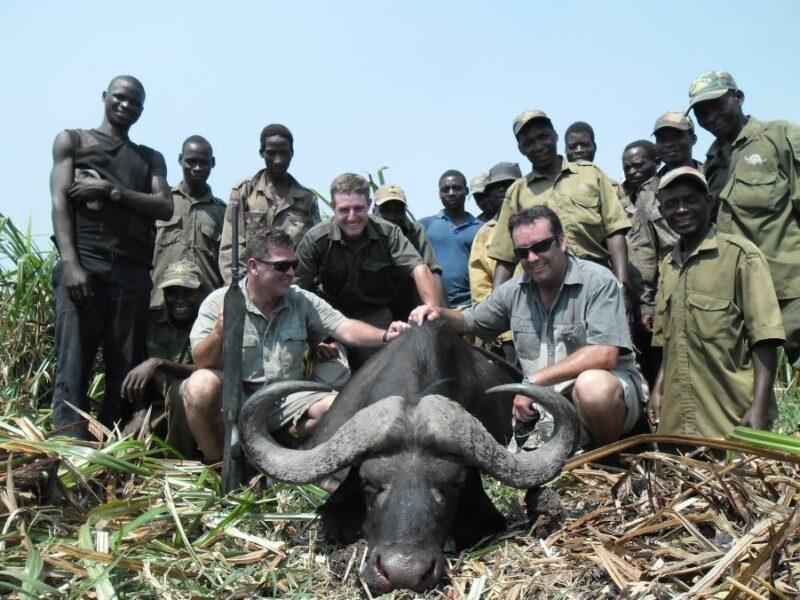
Understanding the Cape Buffalo
Cape buffaloes are often called “Black Death” or “Widowmakers,” reflecting their fearsome reputation. They are known for their aggressive and unpredictable behavior, posing a significant threat to both humans and other wildlife. They are responsible for about 200 fatalities annually due to their relentless attacks once they decide to charge hence it is critical that you a true aim under pressure.
For hunters, the appeal lies in the Cape buffalo’s massive build. Male Cape buffalo, known as bulls, weigh between 1,100 and 2,000 pounds (500-900 kg), while females, referred to as cows, range from 770 to 1,370 pounds (350-620 kg). Both genders possess horns, with males featuring a unique, thick “boss” where their horns meet, providing a protective shield on their heads. This makes them highly sought after in big game hunting.
Cape buffaloes are renowned for their intense confrontations with predators such as lions, often hurling them several feet into the air and using their horns to impale them. They also target lion cubs to diminish future threats to their herd.
Despite their formidable combat abilities, the Cape buffalo is a highly social animal. They often roam in herds of 10 to 20 individuals, and during migrations or breeding seasons, these groups can swell into massive gatherings. This social behaviour ensures they defend each other collectively, coordinating attacks that can overpower any threat they face.
They play a crucial role in their ecosystem by influencing vegetation growth through their grazing habits, benefiting a variety of other wildlife species. They also contribute to conservation efforts through the economic benefits of dangerous game hunting.
In essence, they embody their ominous nicknames through their size, strength, and aggressive behaviour. They command respect and caution in their natural habitats, rightfully earning their name when hunters talk about dangerous game hunting.
"Dagga Boys"
The solitary older male buffalos, known as “Dagga Boys,” derive their nickname from the African word “dagga,” which means mud. This term reflects their habit of frequently wallowing in mud, which serves as a natural cooling method and helps protect their skin from biting insects.
Dagga Boys typically find themselves in solitary existence after being displaced from their herds by younger, more dominant bulls. This displacement usually occurs as a natural part of the herd’s social dynamics, where younger males challenge older ones for dominance and mating opportunities. As they age and become less able to compete, older bulls often find themselves gradually pushed out to roam independently or in small groups.
Despite their solitary status, Dagga Boys remain formidable animals. They are known for their thick, sturdy horns and their ability to survive independently in the wild. They may occasionally form loose associations with other older males, particularly during times of scarce resources or heightened predator activity, where the benefits of safety in numbers become apparent.
The “dagga” boys, which are older male African buffalo, tend to have the impressive trophy horns. So, in my humble opinion it might be worth while to search for the solitary “dagga boys” on your next big game hunting excursion to find a trophy worth the Roland Ward recognition.
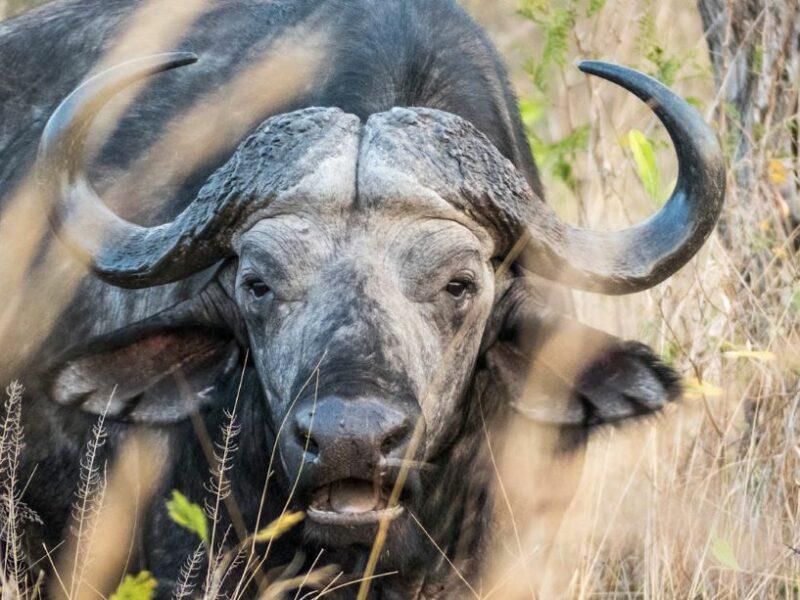
SCI Scoring Cape Buffalo when Big Game Hunting
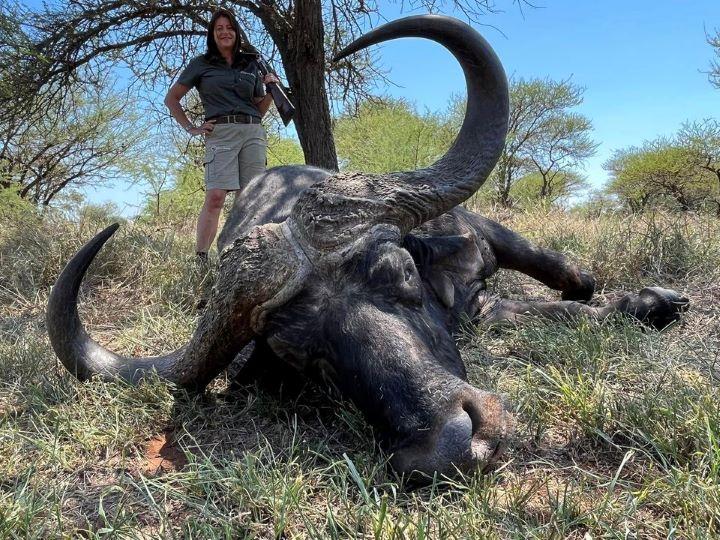
Should you want to measure your Trophy after your African Cape Buffalo Hunt, hunters commonly use two well-known systems: SCI (Safari Club International) and Rowland Ward. SCI is particularly favoured for its comprehensive approach.
SCI scoring canters on key measurements like the bull’s boss, a thick, hardened area on its forehead indicating maturity, and horn spread. A bull with horns wider than its ears by a hand-width (around 34-36 inches) is typically considered over 40 inches in spread, a significant trophy.
Established in 1977, SCI’s Record Book is a respected repository for documenting big-game achievements, verified by Master Measurers for accuracy. Proceeds from SCI’s Record Book and World Hunting Awards fund conservation and anti-poaching efforts, underscoring its commitment to wildlife preservation.
Rowland Ward, in contrast, focuses solely on the widest outside spread of the buffalo’s horns, with a 42-inch spread typically required for entry into its record book. This system promotes sustainable hunting practices that benefit wildlife and local communities alike.
Watch this space! Keep a look out for the second segment of this blog, coming soon!
Author: R du Toit
